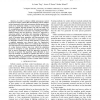399 search results - page 79 / 80 » Humanoid robot HRP-3 |
IUI
2005
ACM
13 years 10 months ago
2005
ACM
We describe a method for predicting user intentions as part of a human-robot interface. In particular, we show that funnels, i.e., geometric objects that partition the input space...
IROS
2009
IEEE
13 years 12 months ago
2009
IEEE
Abstract— Man-made real-world environments are dominated by planar surfaces many of which constitute behaviorrelevant entities. Thus, the ability to perceive planar surfaces is v...
ICRA
2007
IEEE
13 years 11 months ago
2007
IEEE
— In order to achieve reliable autonomous control in advanced robotic systems like entertainment robots, assistive robots, humanoid robots and autonomous vehicles, sensory data n...
ICPR
2008
IEEE
14 years 6 months ago
2008
IEEE
Recently, there is a growing interest in automatic recognition of human motion for applications, such as humanoid robots, human activity monitoring, and surveillance. In this pape...
ICAC
2008
IEEE
13 years 11 months ago
2008
IEEE
We describe an automated method to generating models of an autonomic system. Specifically, we generate UML state diagrams for a set of interacting objects, including the extensio...

